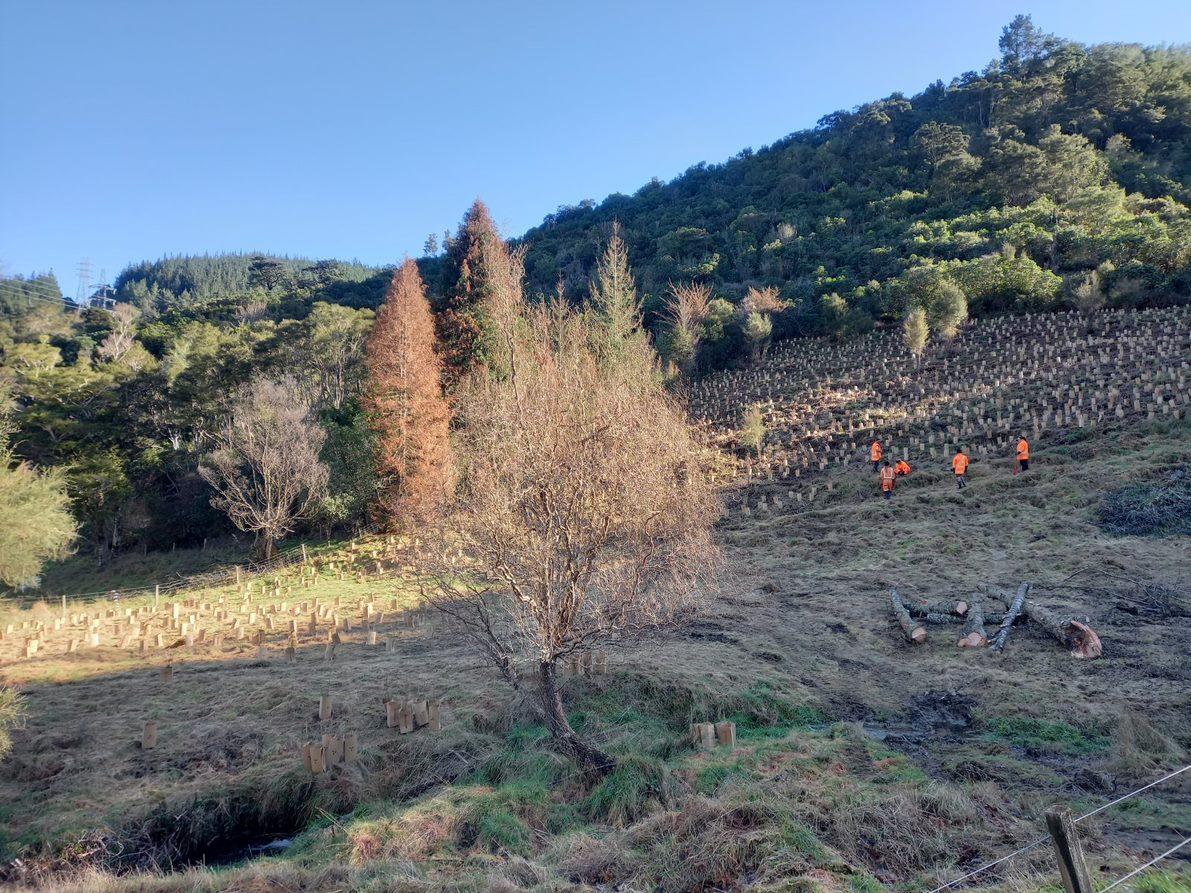
51 minute read
Impact
Impact
Where we work
Advertisement
The map below denotes the main regional projects only, not all the conservation work undertaken by the partners to the Alliance. The key projects are summarised in greater detail in the following section.

Key highlights
Partnered with
The Nature Conservancy
(TNC) to provide independent professional programme implementation of the Kotahitanga mō te Taiao Strategy. Creation of the
Ecosystem Health scorecard
to enable the Alliance to hold a common view of current state and ‘what good looks like.’ Our Ngā Awa project in the Te Hoiere / Pelorus catchment now operates under its own governance and the guidance of an Integrated Catchment Enhancement Plan.
Mt Richmond Forest Park
Wilding Conifers project collaborative conifer control is operational with Tasman District Council the lead.
Approximately $20M of Jobs for Nature (J4N) projects were stood up to contribute to our Strategy.
Mahitahi / Maitai catchment scale restoration was stood-up at pace, replicating the Pelorus / Te Hoiere learning.
Project Moturoa capacity building is in year 3 of implementation, with approximately 20 participants successfully completing the Level 4 Kaitiaki Whenua qualification.
Nature Connection Education – our Kotahitanga mō te Taiao J4N project with partner Whenua Iti to connect 18,000 children to nature.
Picton Dawn Chorus – a community-based organisation working to restore our native birdlife, flora and fauna by removing introduced predators.
Restoration of high biodiversity value sites in Wakapuaka and Whangamoa catchments, including iwi-owned land.
Restoring and Protecting
significant flora ecosystems at scale across the northern South Island / Kotahitanga mō te Taiao rohe.
Wasp Wipeout
– working with Stuff media, TNC and Kotahitanga mō te Taiao we are exploring new tools to manage wasps at scale.
Project Moturoa
Programme development
From its outset the intention of Project Moturoa was to help improve capacity for Te Tauihu iwi to manage land within their rohe and to build iwi capacity by training rangatahi to rangatira in conservation. Whilst the programme is primarily designed towards Māori, spaces are available for non-Māori wishing to explore conservation through a Mātauranga Māori lens. The programme is now in its third year of delivery and feedback from industry and students is very positive.
End of course outcomes
Course numbers have been steady and the quality of the delivery, and the value of the work, is continually improving. Students have gone into various roles including with Department of Conservation on the West Coast of the South Island, work with GIS, environmental work locally, further study within Nelson Marlborough Institute of Technology (NMIT) and Kaitiaki Whenua roles with local iwi.
Successes and highlights
The biggest success is seeing the growth and development of the students. Many students start the course lacking in confidence. However, throughout the programme they flourish, become comfortable in leadership roles, and share their learnings with fellow students. Other successes and highlights include mahi on Rangitoto ki te Tonga, gaining first-hand experience with tikanga around a whale stranding and tuatara translocations. Ties with the Kotahitanga mō te Taiao Strategy

All five outcomes of the Kotahitanga mō te Taiao Strategy are connected to this programme. Project Moturoa programme content and practical elements (weed management, pest control, NZ flora and fauna, bird monitoring, risk assessment, NZ ecology) are geared towards Outcome 5, ‘Ecological connections and resilience are protected, restored and enhanced’. A perfect example of Outcome 1, ‘Native species, including those found nowhere else, are thriving’ is the translocation of tuatara from a breeding programme based in Invercargill on to a small island off Rangitoto ki te Tonga.
Summary
Heading into the fourth year of delivery, the programme is going from strength to strength with tangible gains for all conservation programmes at NMIT. Project Moturoa work closely with the Trainee Ranger classes, who both benefit strongly from each other. Enrolment numbers this early on for 2022 are strong and the programme is ready to be led by a secure and dynamic tutor team.
Project Moturoa
Credit: NMIT

Project Moturoa
Credit: NMIT
Student, Logan Miller
Credit: NMIT

Te Hoiere / Pelorus Project
Planning, planting, gathering, sharing knowledge, and a funding injection that’s creating jobs while protecting nature. It’s been a happening year for Te Hoiere / Pelorus Project.
Highlights include:
• Conservation Minister Kiri Allan announces $7.5 million of Jobs for Nature / Mahi mō te Taiao funding, at Titiraukawa where the Rai flows into
Te Hoiere / Pelorus River. This pushes the Project into the next phase of employing people to boost community conservation efforts. A nursery is being built on Ngāti Kuia land to grow locallysourced plants. The Environment Ministry also committed $1 million from its Freshwater
Improvement Fund. • Catchment condition surveys built a picture of what’s going on in Te Hoiere rivers and streams so efforts can be concentrated where benefits will be greatest. Data has been analysed and recorded on maps given to landowners along with individual advice. • People gather to celebrate the Integrated Catchment Enhancement Plan which charts the course for looking after natural ecosystems ki uta ki tai (from the mountains to the sea) while sustaining communities. • Experiences, thoughts, and feelings of people who live, work, and recreate in Te Hoiere catchments are captured in the Plan’s bottom-up vision, principles, and aspirations. • Community planting events on the Fox and
Richmond family farms and at Ronga Reserve with local people of all ages and Forest & Bird supporters lending a hand. • Conservation Kids lead by example, training to use a Stream Health Monitoring and Assessment
Kit (SHMAK) then signing up to monitor streams for 12 months.
• Dung beetles are released onto farmland, organised by the Marlborough District Council.
The beetles eat and bury manure which can no longer be washed into waterways. Burial breaks the parasitic worm life cycle, meaning less drenching for farmers.
On the downside, severe flooding tested the endurance of many Te Hoiere people. Fences were damaged, trees pushed around, water supplies destroyed, and plantings lost. Life’s been especially challenging for those stuck on the wrong side of slips. The resilience of the community has been truly tested this year and it has been heart-warming to witness people helping each other with recovery with assistance from supporting agencies, Waka Kotahi, and the central government. The Pelorus Project covers over 10,700 hectares of Marlborough catchments whose waters merge in Te Hoiere river and Havelock estuary.
Minister Kiri Allen’s visit to Te Hoiere during her announcement of Jobs for Nature Funding at Titiraukawa
Credit: Andrew Strugnell
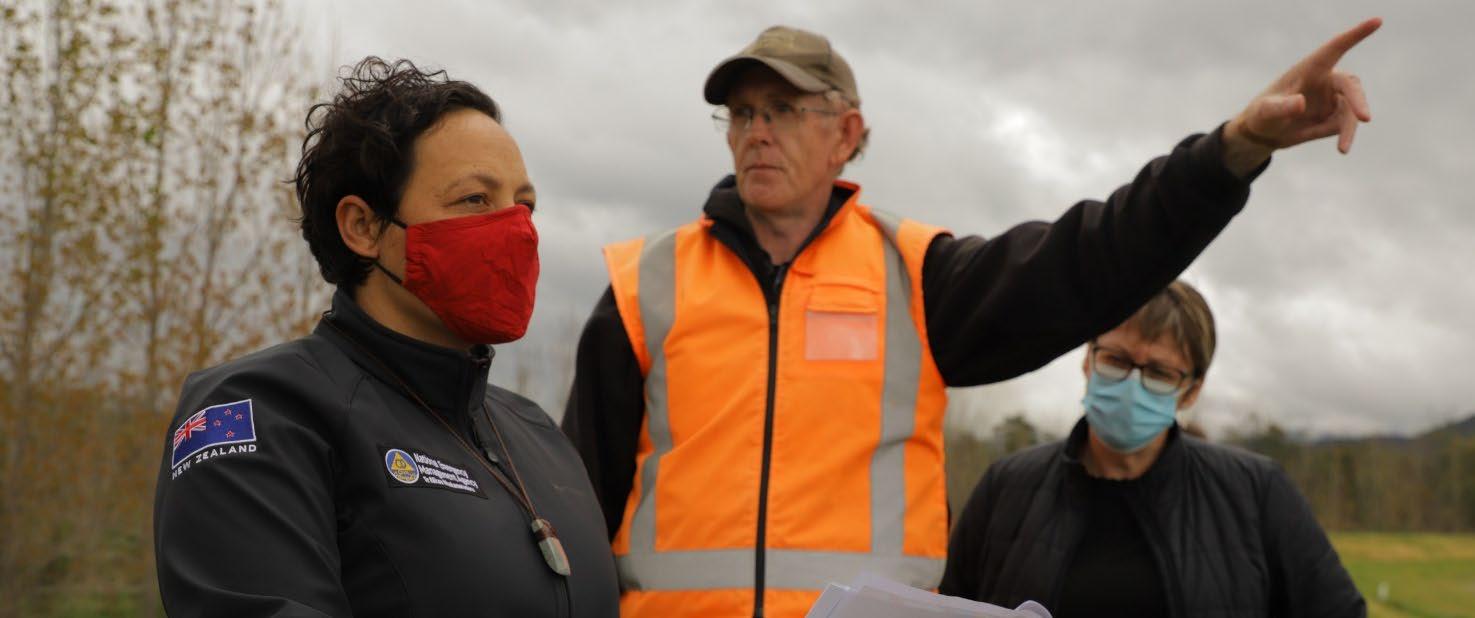
Project Mahitahi
Project Mahitahi is a collaborative project aimed at restoring the ecological health of the forest ecosystems of the Maitai / Mahitahi / Maitahi catchment. By controlling pest plant and animal invaders to a level that will give our native biodiversity a better chance of surviving, and supplementing these areas with planting, we aim to support a thriving bio-corridor.
Project Mahitahi was launched one year ago, and the table below sets out the Project targets against what we have already achieved. This is particularly impressive considering much of the work had not begun until the early part of this year and has involved a lot of people, many of whom were new to conservation work. This great start to the Project has been achieved through their enthusiastic commitment to environmental work, but also facilitated by the generous support of their employment hosts, who have provided excellent mentoring and training.
Task
Animal Pest Control
Pest Plant Control
Planting incl. Taonga Species Wetland Actively Managed FTE Roles Created Year One: Target Year Five: Target Year One: Actual 12 ha 24 ha 98 ha
8 ha
4 ha
0 24 ha
32 ha
0.7 26.3
7 ha (30,000) 0.6
15 54 15.25
Other Achievements
Possum Control
Ungulate Control Community Events No People Attending Plantings 1000+ Possums trapped for skins 20+ Deer and 70+ Goats shot by single hunter 6
250+
Controlling Old Man’s Beard
Credit: Rod Alexander, Kūmānu Environmental

Employment through Project Mahitahi – Jobs for Nature
Since the Project began, 40 people have been employed across the various sub-projects. Those people who have left the Project, have moved on to more permanent or more senior roles, which reflects one of the aims of Jobs for Nature – to help find further permanent positions for the people it employs. One of the roles under Project Mahitahi is a 0.5 FTE training advisor, who co-ordinates training for most field staff. Along with formal, tailored training, there have also been informal opportunities such as accompanying DOC or Council staff on fauna surveys.
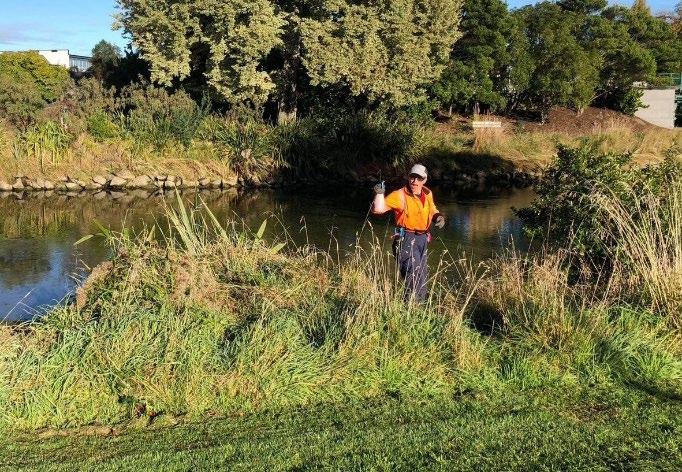
Collecting old fly tipping rubbish onsite
Credit: Rod Alexander, Kūmānu Environmental
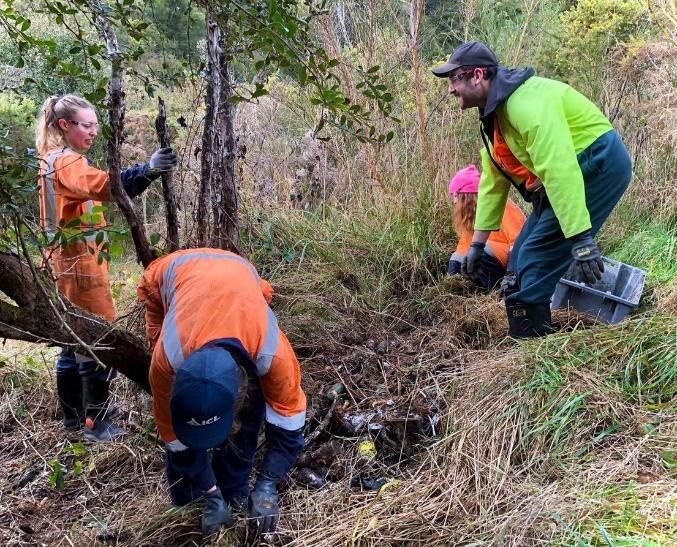
Pest Plant Control
The focus of pest plant control has been on particularly damaging species such as vine weeds and pest tree species including Sycamore, Wilding Pine, and Crack Willow. The river corridor has some very steep slopes that carry a burden of weed species, however these areas are largely inaccessible to field staff, particularly to those new to this type of work. As always, the health and safety of staff is a very important aspect to consider.
There are limits to how much of the catchment can be managed. Concentrating on key areas helps to ensure that work is contained to a level that will be sustainable following the Project’s end. The expectation is that once Project Mahitahi officially concludes, these key areas will be well planted with canopy closure, and key weed species will be controlled to a level of surveillance control.
Collecting old fly tipping rubbish onsite
Credit: Rod Alexander, Kūmānu Environmental
Tree Planting Programme
Of the first 30,000 plants in the ground, more than 3000 are taonga species amongst existing firstgeneration plants. The planting has been undertaken by field staff but has also been assisted by six community planting projects. Many of the trees have been provided through the support of Ministry for Primary Industries.
Pest Animal Control
Project Mahitahi has now established pest trapping networks, covering more than 98 ha of our conservation reserves, serviced by Project Mahitahi field staff with the intention that they will eventually become community trapping projects. One hunter is employed for an average 8 hours per week, and two people are employed to trap possums. These three Project Mahitahi staff have trapped more than 1000 possums and culled 20 deer and 70 goats over the last few months. An impressive effort in a difficult landscape.
Information about Project Mahitahi
If you would like to sign up to the Project Mahitahi, 6monthly newsletter, contact: project.mahitahi@ncc.govt.nz
Project Mahitahi end of year celebration
Credit: Project Mahitahi
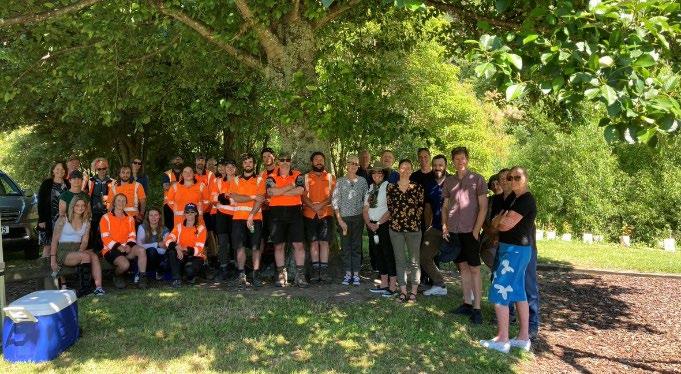
Mt Richmond Forest Park Wilding Conifers Project
around 10,924 hectares with Aerial Basal Bark Application (ABBA) method.
Wilding pine workers
Credit: Action Forest Management

Tasman District Council’s wilding conifer control efforts, under the Jobs for Nature programme, have progressed well during our Year 1 period of engagement.
Following a winter hiatus, crews have restarted work in the Mount Richmond Forest Park Management Unit and expectations are high in making a further impact on the biodiversity of some of our special natural areas.
In late 2020 the Tasman District Council, a Kotahitanga mō te Taiao Alliance partner, teamed up with independent forestry management providers PF Olsen, to commence wilding conifer control in the Management Unit, which covers around 283,000 hectares across Te Tauihu and traverses through private, public, and conservation lands. Mount Richmond Forest Park has unique ecosystems developed on mineral-rich geology; plants found nowhere else which are taonga but are at risk of being lost as the area becomes a pine forest. The area is of national park quality, and we are making great strides into restoring its outstanding natural features.
Despite the challenging terrain and the ongoing effects of COVID-19, the results since the start of the Project have been encouraging – and noticeable – across the management area.
The PF Olsen crew and their contractors have treated over 11,000 hectares of land affected by wilding conifer infestations in MRFP, totalling to around $1.45 million spent on control operations in 2020/2021.
Around 321 hectares has been treated with groundbased herbicide injection (‘drill and fill’ methods) and We have employed two FTEs since mid-March thanks to J4N funding (DOC funded via Alliance), while another five have been employed since December under the National Wilding Conifer Control Programme. Among those employed included our contractors first female silviculture crew members and recruits coming from outside forestry or conservation backgrounds. The reality is that this Project will be long term in order to effectively control the large-scale infestation across the entire management unit. However, the collaboration undertaken between parties so far has proved beneficial in reducing the spread of wilding conifers.
We’ve also been pleased to support efforts to eradicate wilding conifers from sections of the Tākaka Hill by our partners Tākaka Hill Biodiversity Group Trust (THBGT), awarding $250,000 for years two and three of its control work programme. The Tākaka Hill project is independent from our work around the Mt. Richmond Wilding Conifer Control programme. However, we are working in partnership with THBGT as they look to further expand upon that initial control and undertake significant work on public conservation land within Abel Tasman and Kahurangi National Parks.
We are grateful for the Alliance’s support in our efforts to rehabilitate coastal areas through the Waimea / Waimeha Inlet Enhancement and Billion Trees Projects.
We are also looking forward to continuing our Freshwater Improvement Fund initiatives to rejuvenate key habitats over the next five years. With support from Jobs for Nature – Mahi mō te Taiao funding, our Fish Passage project aims to improve fish diversity and abundance throughout the district by restoring fish passage in stream structures, while seven constructed and 40 natural wetlands will be included in the Wetlands programme.
Through iwi-led education events and Mātauranga Māori monitoring, this project also intends to improve local freshwater knowledge.
Nature Connection Education

Whenua Iti Outdoors (WIO) is a charitable trust located in Lower Moutere, with 35 years of experience delivering experiential learning to schools and communities across Te Tauihu and Te Tai Poutini with the aim of inspiring positive change.
The Kaimahi for Nature Connection project, which commenced in February this year with the support of funding through Jobs for Nature is all about connecting as many young people in Te Tauihu and Northern Te Tai Poutini to te taiao (the environment) as possible, helping them learn about it and look after it, in order for them to develop into the kaitiaki of the future. WIO does this by utilising existing partnerships with schools, iwi, and community groups. Project Achievements 2021
Employment and training
By May, WIO had employed 5 new experienced educators (three of whom had lost their jobs as a result of international travel ceasing), 1 project lead, and extended the roles & knowledge of existing staff. New and existing staff have completed significant internal and external training in outdoor adventure activities, health and safety, nature connection, and Te Ao Māori.
WIO also hosted over 60 community members, including early childhood, primary and secondary teachers, conservation groups, parents, and education providers in March to hear from a guest nature connection speaker.
Programme Delivery
Whenua Iti successfully delivered a range of nature connection programmes to students from 5 to 18 years this year. The lockdown affected around two months of delivery. However, WIO rescheduled 84% of all lockdown-affected programmes, along with disseminating a widely used set of nature connection activities for tamariki to do at home.
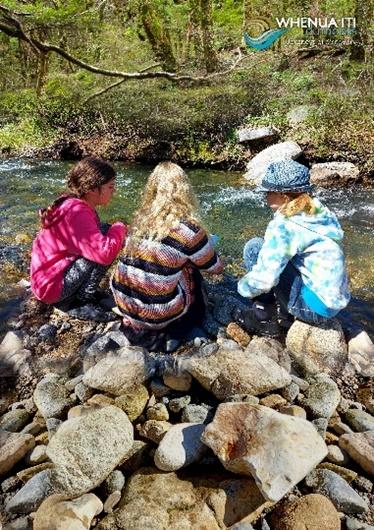
Examples of programmes which received very positive feedback from participants included: • A 3-day “follow a raindrop journey” from the source of the Buller River to the sea for Murchison Area School.
• Hauora (holistic wellbeing) and nature connection day programmes at the Riuwaka Resurgence for a number of local primary schools. • A 3-day whole school Te Ao Māori and nature connection programme with Steiner School. • Two new Kaitiaki Kids holiday programmes where students helped restore the Waimeha / Waimea Inlet by planting trees alongside Rotary. • Beach and camping experiences for the Muslim community.
WIO strengthened partnerships with restoration groups and projects. Approximately 160 students contributed to at least 10 restoration projects, including planting 400-500 trees, weeding, trapping, and species monitoring.

Programme planning and bookings for 2022 are strong and include delivery in the Buller District, Nelson City and Marlborough District.
“The benefits to the students are huge, learning, sharing, participating & working together in nature – (the programme) provides an experience that we cannot replicate at school.”
Teacher feedback, WIO nature connection programme
Rangatahi during the Nature Connection Education programme
Credit: Whenua Iti Outdoors

Restoring and Protecting Flora
Kaituna Wetland, Pernod Ricard Winery, Marlborough
Credit: Hudson Dodd
Weeds are a serious threat to biodiversity across Te Tauihu. This is especially true for the many small, but critically important, remnant areas of native vegetation in our lowland areas that have been subject to extensive past clearance. The Restoring and Protecting Flora project has been established to address this threat across the entire Kotahitanga mō te Taiao project area. Led by The Nature Conservancy, using $6M of Jobs for Nature funding made available by the Department of Conservation, this is one of the larger projects under the Alliance. The project provides a great opportunity for significant outcomes in terrestrial conservation and social wellbeing through employment opportunities. The Project is intended to enable large-scale organised weed management in significant natural areas across the Kotahitanga mō te Taiao rohe and explore expanding the protection of these sites through QEII covenanting and community engagement for ongoing site maintenance.
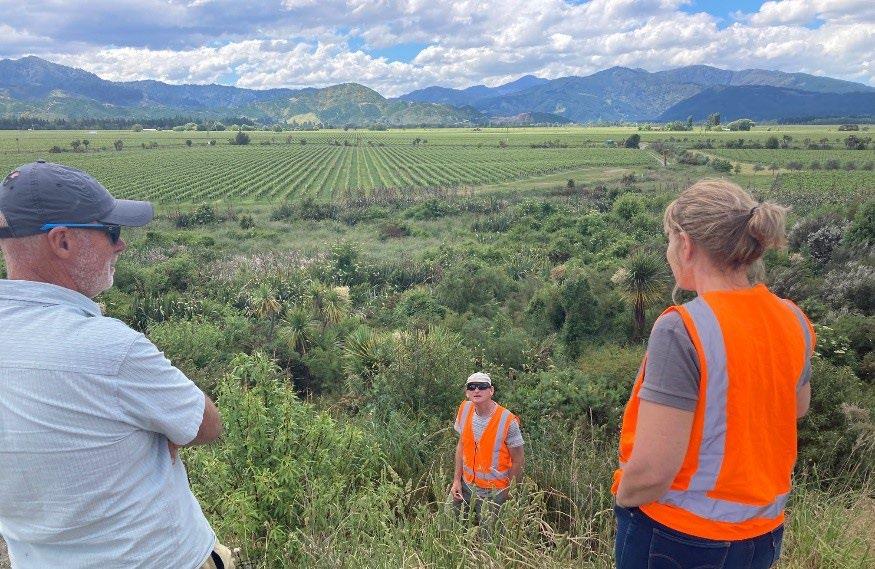
Jobs for Nature funding will go directly to employing and mobilising teams who can work across different locations and weed species. Project teams will undertake surveillance, ground and wetland weed control, and provide support to public and private landowners. This will build on the skill sets of existing conservation trusts and contractors throughout the top of the South.
In doing so, additional employment and training opportunities will be created by leveraging off these already established organisations and programmes. A general list of sites was agreed at the Project’s initiation, and the various Alliance partners and contractors are working together to expand the list to hundreds of sites, with more detail and rationale in order to best meet the objectives. Over the life of the project the aim is to provide 87 FTE and weed control across 35,000 ha. Standing up this project has taken a number of months; however, the majority of Project resourcing is now in place with work well underway in the area of planning and work on the ground having commenced in most of the Project areas.
The teams are gelling at the various Councils, and contractors have already begun logging hours worked and hectares treated.
Picton Dawn Chorus
Picton Dawn Chorus (PDC) was established in 2016 with the plan of surrounding the Kaipupu Wildlife Sanctuary with a predator free halo. Trapping, on Kaipupu, was being thwarted by the influx of rats swimming to the peninsula from surrounding headlands. Initially PDC set out to trap throughout the Victoria Domain, east of the sanctuary. Next, PDC established a good network of traps throughout the urban areas of Picton and Waikawa and recently traps have been established over the Wedge, west of the sanctuary.
The land being trapped includes private land, DOC land, and Marlborough District Council land. Twelve months ago, PDC commissioned an Operational Plan from Andrew Macalister which outlined an area of close to 5000 ha surrounding the town and sanctuary. Our plan was accepted by Jobs for Nature (J4N) as a worthy recipient of a grant and now we have employed our full quota of staff, who are employed for the next three years. We are impressed with the quality of our appointees and look forward to good progress on the ground.
Initial work will entail a review of present trapping procedures followed by a full audit of all existing trap lines, before moving out to the enlarged trapping area. The structure of the PDC organisation has stood up well to the influx of extra staff with administration managing the transition effectively. PDC is well structured with a Board of Directors, paid staff (thanks to J4N) and a multiple of volunteer management working groups, including Bush Trapping, Urban Trapping, Communications, Forest Regeneration (Urban and Bush), and Social Enterprise (Dawn Chorus Trapping Enterprise (DCTE)).
There are 170 volunteers listed, 2000 traps laid in the bush and 350 traps registered through the town; Picton can be classed as a Conservation Town with more than 10% of the community actively involved in predator control. To date we have accounted for the demise of over 12,000 predators. There is a positive air around the community thanks to the Jobs for Nature initiative. However, the Board is well aware of the potential shortfall of funds, to be addressed over the next three years, and the future needs for funding to sustain the long-term sustainability of our Project.
The Pebble (DCTE volunteers office)
Credit: Picton Dawn Chorus

Programme
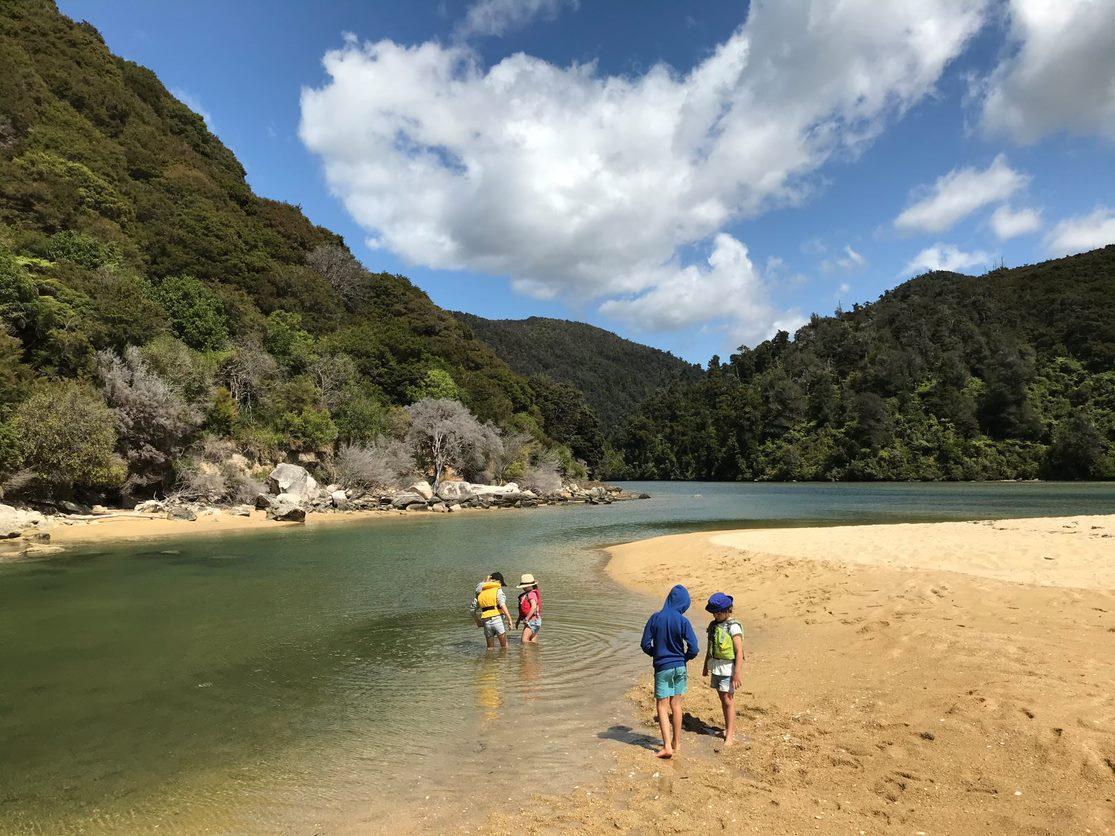
Ngāti Kuia Trust Bee Apiary students
Credit: Melissa Banks Photography
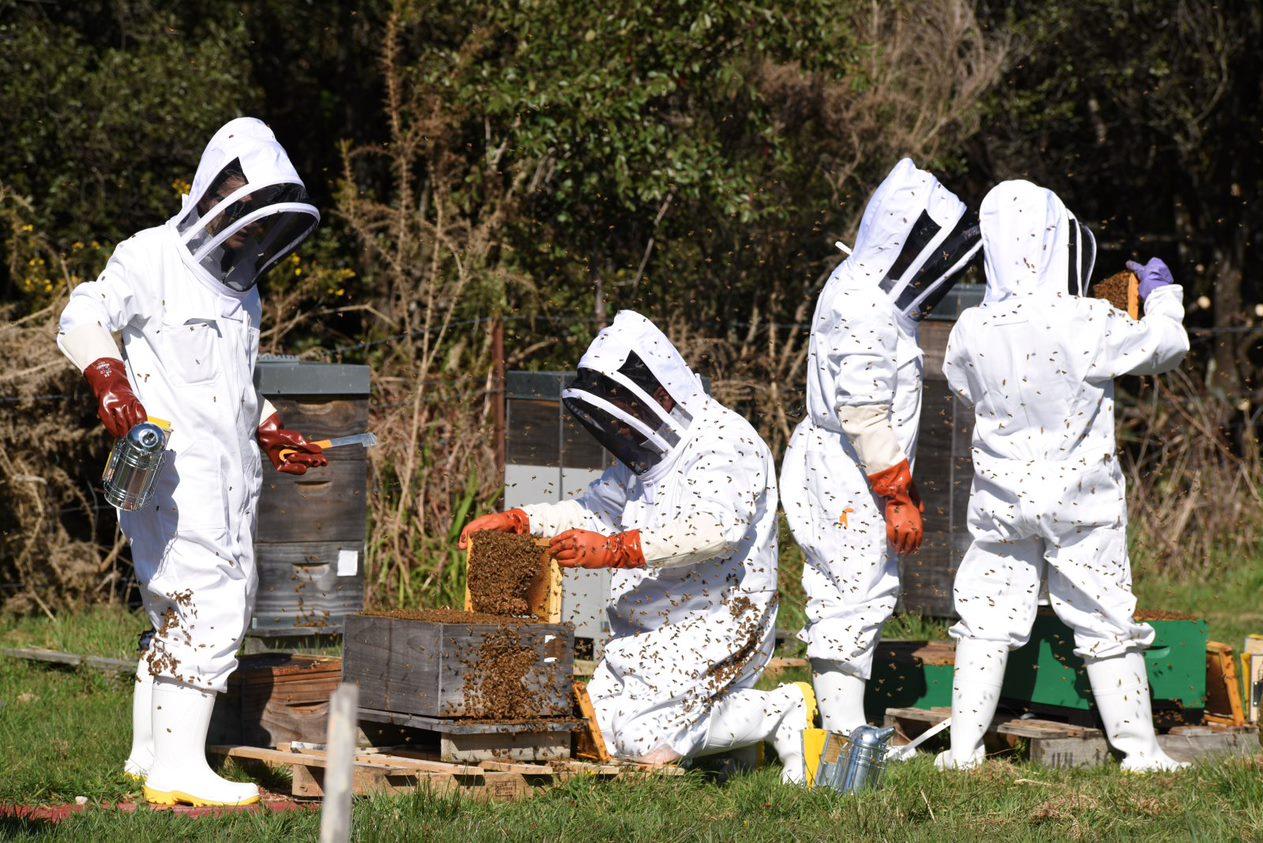
Feature: Health Report Scorecard
Ecosystem Health scorecard framework
Heaphy Track
Credit: West Coast Regional Council

To help inform and support conservation and restoration efforts, the Kotahitanga mō te Taiao Alliance is developing measures of ecosystem health, which may eventually encompass aspects of iwi and cultural values, and social and economic wellbeing. These measures tell us how ecosystems are faring and, over time, will tell us whether our efforts to restore ecosystems are working. The Alliance was fortunate to have the generous support of Greg Low, a global expert in conservation action planning who facilitated the development of an Ecosystem Health Scorecard for land and freshwater in the Kotahitanga mō te Taiao focus area. This included the development of a series of measures which are high-level and integrated over large landscapes. Although the health of a given ecosystem is determined by a complex set of components, the measures were designed to inform an overall picture of health.
Ultimately, the intention of the Ecosystem Health Scorecard work is to: • show the health of the region’s varied ecosystems • provide information to decision-makers and stakeholders • define ‘what is success’ for the Alliance strategies • help prioritise and focus strategies on key factors, and • engage communities and stakeholders in monitoring the health of our environment.
The measures were developed by a working group, using a proven, longstanding approach. Eight facilitated workshops were held in person or virtually to develop the measures. The measures are designed to be understandable and relevant to local communities, as well as to capture the best available science knowledge and perspective. For a comprehensive understanding about the Alliance Scorecard please visit our website: https://bit.ly/3p5NJNf.
At a landscape-level, they show that the upland ecosystems tend to be in relatively good condition, notwithstanding the ongoing impact of pests, and the lowland ecosystems tend to be in poor condition due to the impacts of past clearance and ongoing impacts from human activities.
Condition
Excellent
Rivers & Streams Forests Other terrestrial ecosystems Lakes & Wetlands
Upland lakes & wetlands
Good
Good / Fair
Fair
Poor
Very poor
Upland rivers & streams
Steep lowland rivers & streams, valley floor rivers
Lowland streams Upland forests
Steep lowland forests
Valley floor forests Alpine, downs, caves
Marble, mineral belt, coastal turf, frost flats*, cliffs* (*NW Nelson) Coal measure, barrier banks, seabird soils* (*NW Nelson)
Coastal cliffs*, seabird soils* (*Nelson Motueka)
Dunes, frost flats* (*Nelson Lakes) Lowland lakes
Lowland wetlands
The Alliance seeks to change the quality on the scorecards over time from poor to fair to good. Strategies for the conservation and restoration of all impaired ecosystems need to be scaled-up and deployed at a landscape-level, over many years, to achieve the desired future health of the region’s ecological taonga.
The scorecards are a work in progress and are not yet complete. The aim for the Alliance is to continually improve measures or wellbeing indicators that focus on the mission, goals, and strategies of the Alliance. The aspiration is that the Alliance Strategy and the strategies and partnerships, such as Te Tauihu Intergenerational Strategy influence the success of our ecosystem health measures and framework. Alliance leaders are also committed to undertaking a full, iwi-led development of iwi specific cultural health measures as vital next steps to help set strategy priorities, evaluate opportunities, and assess project activities.
The ecosystem health scorecards are meant to be a “credible first iteration.” As soon as they are published there undoubtedly will be new information that becomes available, new, or different science hypotheses, and differing interpretations and opinions on some health scores. Over time, circumstances will change on the ground – both for better and for worse in terms of ecosystem health. Over time, the Alliance will build on and refine its approach to understanding the state of te taiao and the success of our restoration efforts.
Programme Financials
KMTT Funding
Because the Alliance is not a legal entity, it is not required to report as per notfor-profit organisations and businesses. However, the following sections broadly outline financials for some aspects of the Kotahitanga mō te Taiao Alliance’s work for the 20/21 FY.
The way the Alliance obtains resources to deliver its work programme is complex and comes from many different sources including: 1. Direct financial contributions for core functions e.g., programme management and communications.
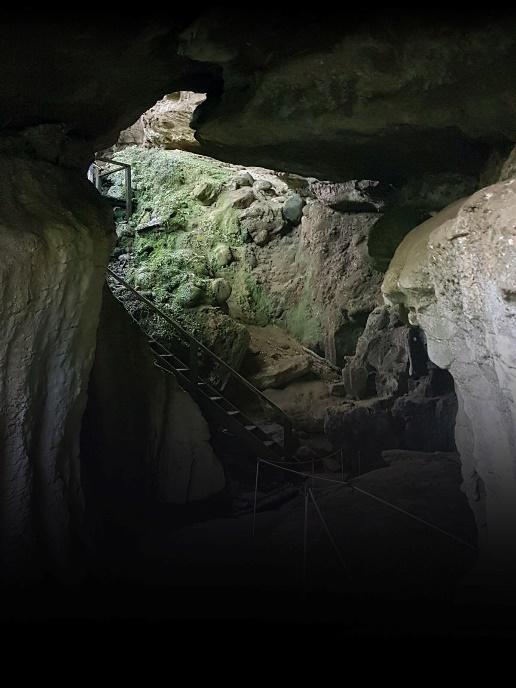
2. Government grants e.g., Jobs for Nature, Te Mana o Te Wai, Ngā Awa.
3. Philanthropic grants.
4. In kind contributions e.g., staff time – which are difficult to estimate.
5. Volunteer contributions.
Cave in Buller
Credit: Buller District Council
Funding for core programme management functions is pooled from the Alliance partners and hosted by The Nature Conservancy. The following tables outline the Income and expenses for the 20/21 Financial Year for these core functions.
2020/21 Expenses
Item
Operating
Administration
Programme management Communications
TOTAL Expenses Forecast budget
$2,000 $8,000 $130,000 $43,200 $183,200
Actual expenditure
$1,034 $4,137 $67,218 $15,000 $87,389
Committed expenditure Variance to Budget
$966 $3,863 $62,782 $30,120 -$1,920 $30,120 $65,691
2020/21 Summary
Income
$179,185 $117,509 $61,676
This year saw unprecedented government grants into Alliance partner projects, largely due to the Jobs for Nature programme. Alliance members obtained $20.78 million for delivery of projects aligned to the Alliance Strategy over the next 3-5 years. Further significant funding has been provided to non-Alliance members which will make meaningful contributions towards delivery of the Strategy.
Expenditure Surplus
Activity Dashboard
Operational Projects
Not including those already profiled in this report.
Waimeha / Waimea Inlet Restoration
1 Billion Trees (Phase 2) – More than 70,000 natives are to be planted in the course of the fiveyear project, employing 12 FTEs. 26,000 natives being planted across three sites since June. Spring saw a switch to maintenance. Further planting in 2022.
Enhancement Project – the first year has laid a good foundation to build on in future years. A consultant has been engaged to undertake a review of the Waimeha / Waimea Inlet management strategy and action plan. Contractors have undertaken weed mapping across the entire inlet and formulated a pest plant management strategy that will further inform control for the next five years. Work already undertaken includes wide-scale management of problematic weed species such as tamarisk, jellybean iceplant and Juncus gerardii. Planning and design of a wetland creation project in the Waimeha / Waimea delta area is underway with the overall aim of creating habitat for rare marshbird species.
Tasman Wetlands and Fish Passage
These Jobs for Nature funded projects aim to restore wetlands and reduce impediments for natural freshwater fish movements across the Tasman Region.
Kerry South has been appointed to manage the fish passage project.
Decisions on tenders/proposals for assessing and remediating in-stream structures for fish passage have been completed. Training and development of the field team has begun, and the communications plan is being implemented.
Most of the work will be on private land throughout Tasman. Golden Bay/Mohua will be a priority given the high fish diversity and abundance in that area.
Blair Reid has been appointed to manage the wetlands project with support from Kerry South. Two science/technical advisory panel workshops delivered 18-19 August.
Planting of Motupipi catchment under way. Videos about projects: Freshwater Improvement Fund projects | Tasman District Council.
Picton Predator Control
The Picton Dawn Chorus/Te Ātiawa o te Waka-a-Māui community group has received $700,000 Jobs for Nature funding to support three-fold expansion of its predator trapping area over the next three years. Picton Dawn Chorus currently carries out trapping over 240 hectares. This trap network will be intensified, and the group will increase its trapping activity to cover 4815 hectares of Picton township and surrounding hills.
The Jobs for Nature funding will create 18 fulltime-equivalent roles across three years, including for bush trapping work and cutting tracks for maintaining traplines, trapping and volunteer coordination, and administrative support.
Whakapuaka / Whangamoa Restoration
The project is currently in the set-up phase.
Nelson City Council has been successful in securing $990,628 of funding from DOC’s Jobs for Nature (J4N) Biodiversity on Private Land fund to restore sites of high ecological value on private and Māori owned land in the Wakapuaka and Whangamoa catchments.
The project is endorsed by Ngāti Tama ki te Waipounamu Trust, the Wakapuaka 1B Trust, and the Kotahitanga mō te Taiao Alliance.
The three-year J4N project will start in 2021/22 and employ a team of 3 full time staff for the project term with an additional team member focused on integrating Mātauranga Māori for years 2 and 3.
The main activity focus is to create a step change in the control of vine weeds. Other activity includes controlling wilding pines, possums, and restoration planting. NOTE: Managed under Kotahitanga ki te Uru Alliance. The Jobs for Nature Sustainable wild whitebait fishery project on the West Coast has recently been approved and the contract is currently being executed.
West Coast Whitebait Habitat Restoration
The West Coast Regional Council led project is for $1.3 million and creates 17 FTEs over the next 2 years. The project focuses on increasing whitebait stocks by creating and enhancing whitebait habitat throughout the West Coast through weed control, fencing, channel creation, and identifying barriers to movement of fish between spawning sites and adult habitat. The project includes a number of sites in the Buller where the weed control and fencing activities will be undertaken.
Enabling Projects Workstreams
Communications / Brand
Purpose:
Share Kotahitanga mō te Taiao (KMTT) stories with our audience and support KMTT projects.
Relationship management / Stakeholder engagement Purpose:
Build and manage relationships with KMTT partners and stakeholders.
ePānui have continued. Networks with communications staff and project managers established. Brand kete completed. Facilitated meetings of project managers for significant Te Tauihu projects are being held every 6-weeks to share success and learnings, and to provide mutual support for implementation.
Ongoing engagement with organisations aligned to the KMTT mahi.
Status: Active Status: Active
Youth Project
Purpose:
Provide a youth voice and perspective for KMTT work.
On hold.
Status: On hold
Conservation planning
Purpose:
Carry out full conservation action planning using the Conservation by Design 2.0 framework.
Early design of the full planning process underway. Partner capacity assessments, stakeholder mapping, and spatial data collation and analysis will be amongst the first activities. The process will ultimately deliver a plan that will operationalise the KMTT Strategy.
Status: Active
Measurement and reporting
Purpose:
Determine the baseline state of the KMTT rohe and develop systems to track progress for delivering on the KMTT strategy.
Ecosystem health scorecards have been completed for all terrestrial and freshwater ecosystems. A framework has also been developed for measuring social and economic wellbeing. Measures for Māori cultural values and marine and estuarine systems remain to be developed. Exploring high-level connections to other monitoring frameworks.
Status: Scoping further work
Project support roles
Purpose:
Provide additional capacity for project scoping and project management for partners with capacity constraints.
Both positions filled and focused on supporting establishment of the Restoring and Protecting Flora Project, mapping Te Tauihu Project and scoping Wairau Lagoon restoration project.
Status: Active
Awa – Te Tai Poutini
Credit: West Coast Regional Council

Partners

Ngāti Apa ki te Rā Tō Charitable Trust
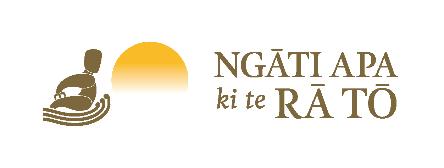

Credit: Dr Jen Skilton
Ko Ruatea te tangata Ko Kurahaupō te waka Ko Ngāti Apa ki te Rā Tō te Iwi
Ngāti Apa ki te Rā Tō have an unbroken historical, traditional, and spiritual association with the whenua of te taiao o te Waka-a-Māui, stretching back hundreds of years. The trails of our ancestors connected settlements across our vast rohe, from Tōtaranui, Te Tai-o-Aorere, Mohua, Te Taitapu, Te Kawatiri, and inland into Rotoiti and Rotoroa. These trails were central to maintaining the unity, mauri, and integrity of our iwi in early times. The values of Ngāti Apa ki te Rā Tō include kotahitanga, kaitiakitanga, manaakitanga, whanaungatanga, and whenua/manawhenua. These values align with those of the Kotahitanga mō te Taiao Alliance and we support the aim of the Alliance to get the best possible conservation outcomes for people and nature.
Our aspirations for conservation and vision for the responsible and sustainable use of natural resources form important parts of our cultural identity as kaitiaki. We see many opportunities for Ngāti Apa ki te Rā Tō in the taiao space and with the support of the Alliance, we are laying the foundations for some significant projects. Being part of the Kotahitanga mō te Taiao Alliance exemplifies the vision and values shared across the partnership around reviving freshwater catchments, native plants, and restoring our connection to what exists in our Te Tauihu landscapes.
Te Pataka a Ngāti Koata Trust

Mai te awa a Te Hoiere Ki Kurupongi Ki Ngā Kiore Ki Takapourewa Whiti atu ki te hiku o Te Mātau Koata taonga Koatatanga Koata mana e!
Ki ngā tini mate o ia marae, o ia maunga, haere, haere, whakangaro atu rā. Ko te akaaka o te rangi ki a rātou mā, kei a tātou ngā purapura ora, ko te akaaka o te whenua. E rau rangatira mā, e te tini, e te mano, tēnei te tuku mihi ki a koutou katoa i raro i ngā tini āhuatanga o te wā.
Tihei Mauriora!
Ngāti Koata Trust are pleased to be a contributing Alliance member within Kotahitanga mō te Taiao. It has been a full and productive year with much to celebrate in terms of a clear demonstration of what can happen when Crown agencies, local government, iwi partners, and the wider community coming together.
We acknowledge our other Alliance partners for their efforts this year and commend our Alliance Co-Chairs as well as those involved in the numerous projects under the korowai of the Alliance. As well as supporting and contributing to projects across the Alliance, one of the projects that Ngāti Koata directly supports at governance and working group level is Project Mahitahi. We are particularly pleased with the progress and the positive outcomes that have been achieved within this catchment area to date and acknowledge the strengthening of relationships that have also occurred. Ko koe ki tēnā, ko au ki tēnei kīwai o te kete.
Planting trees
Credit: Mahitahi Project / NCC

Te Rūnanga o Ngāti Kuia Trust
Ngāti Kuia rangatahi collecting Pakohe
Credit: Melissa Banks Photography
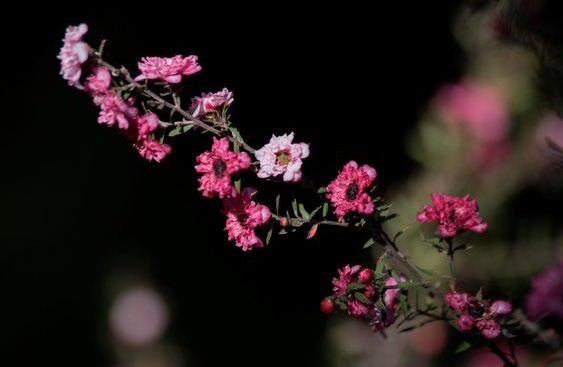
Mānuka flowers
Credit: Melissa Banks Photography
Tāku ara ko Matua Hautere Te Hoiere te waka i topetope ai ngā ngaru Ka puea ake Te Kaitiaki a Kaikaiāwaro i Te Moana o Raukawakawa I arahina ia ki ngā kokoru o Te Tauihu o Te Waka ā Māui Ka hoea te awa ka tau ki te wai pāpaku, ko Te Herenga Ka piki i a Maunganui ki te pīnakitanga o Parikārearea I reira ka poua tūāhu ki te one, ka poua tūāhu ki te rangi ka hua ake ko Maungatapu I tapa te awa ko Te Hoiere He wai-Māori mō te tini e whakarauika nei, Ko Ngāti Kuia – He iwi Pakohe – He iwi karakia e
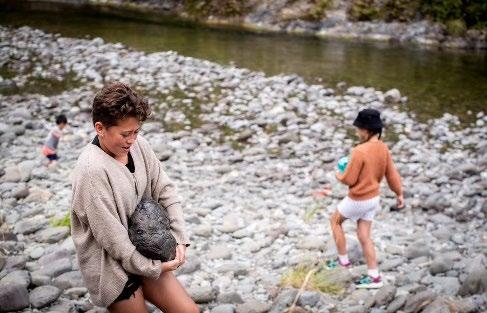
Ngāti Kuia are very pleased to be a member of the Kotahitanga mō te Taiao Alliance. We contribute in this important mahi – Ki uta, ki tai (from the mountains to sea). From our chairperson, Waihaere Mason co-chairing Te Hoiere / Pelorus Project with Barbara Faulls, and the Ngāti Kuia Taiao team, Julia Eason and Lewis Smith sitting on the working group.
Our General Manager Dave Johnston is Co-Chair of the Alliance. The Alliance is creating positive transformational change on the whenua, awa, and moana across Te Tauihu.
Find out more about the Te Hoiere / Pelorus Project in the Impact section in this report. This is one of the projects that Ngāti Kuia directly support from a grassroots perspective to governance and decision-making. Ngāti Kuia looks forward to continual involvement in the coming years, as the Alliance grows and develops from strength to strength.
Te Hoiere / Pelorus Project LEARNZ filming
Credit: Melissa Banks Photography

Te Rūnanga o Ngāti Rārua
Riuwaka
Credit: Naomi Aporo

Ngāti Rārua originate from the western coast of the King Country region and came to Te Tauihu from the 1820s as part of the great southward migration of Kawhia and Taranaki iwi. Te Ao Tūroa, the natural world, is central to Ngāti Rārua identity and cultural wellbeing. We are impelled by deeply held values – including the fundamental tenets of whanaungatanga, kaitiakitanga and manaakitanga – to love and respect Papatūānuku in recognition of her life-supporting function and place in our own whakapapa. The vision and values of Kotahitanga mō te Taiao align well with the aspirations of Ngāti Rārua and we are proud to be a member of the Alliance.
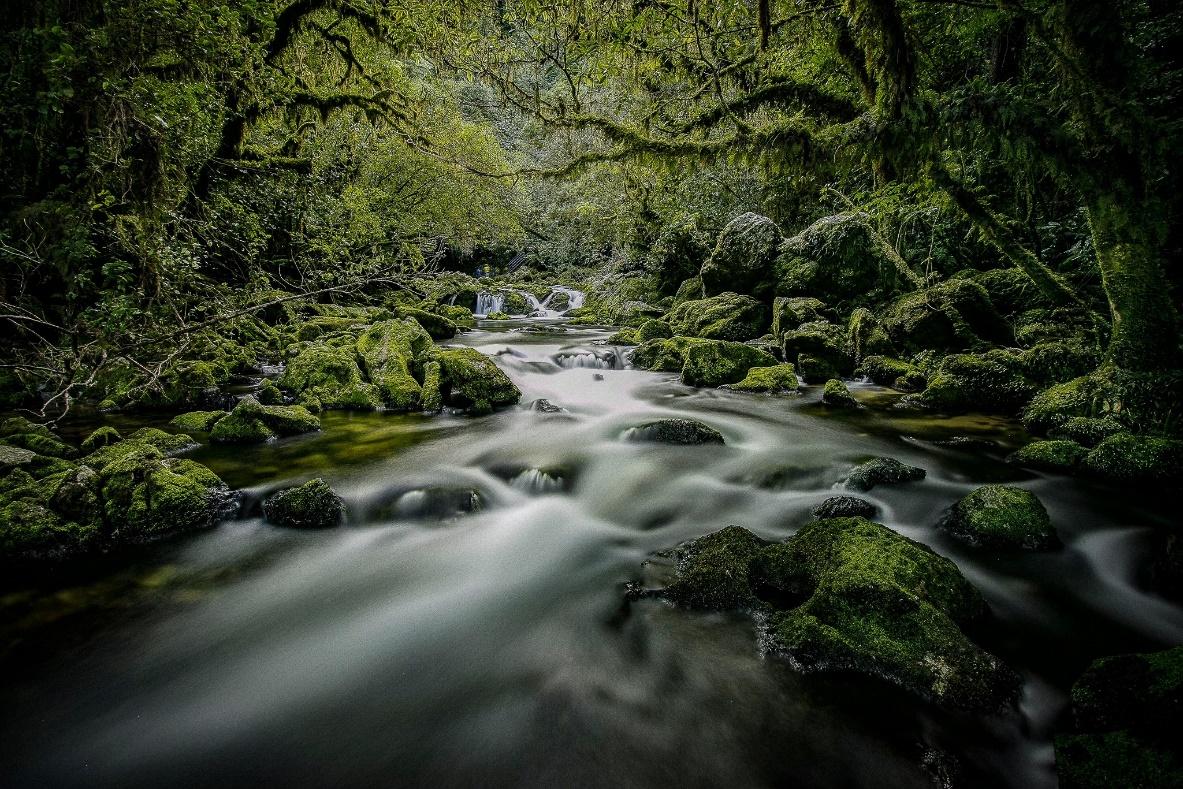
Over the past year Ngāti Rārua has been involved with Project Mahitahi at governance and working party levels. This is an exciting project which is already achieving great things environmentally, as well as socially and culturally. We look forward to being an ongoing part of the Alliance mission and journey.
Ngāti Toa Rangatira

Te Rūnanga o Toa Rangatira as the mandated iwi authority for Ngāti Toa has responsibility for protecting and enhancing the mana of Ngāti Toa across the various political, economic, social, and environmental spheres. In relation to Te Ao Tūroa, Ngāti Toa’s objective is to nurture a resilient environment to sustain future generations through reclaimed connection and Mātauranga to natural resources, empowering kaitiaki who are leaders and comanagers of our natural environment, our commitment to environmental sustainability and our ability to adapt to the impacts of climate change.
The Kotahitanga mō te Taiao Alliance provides an avenue for iwi, Councils, and the Crown to work together in the spirit of partnership and cooperation. The mahi carried out by the Alliance contributes to improving the mauri of te taiao and the connection of tāngata whenua to our whenua and our wai. Ngāti Toa remain abreast of the mahi undertaken to date and look forward to exploring active participation in the future, particularly with regards to exercising our kaitiakitanga and rangatiratanga across Te Tauihu.
Ngāti Tama ki Te Waipounamu Trust
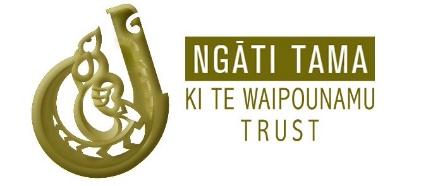
Ngāti Tama ki Te Waipounamu Trust trace their roots to the Tokomaru waka from Hawaiki and take their name from Tama Ariki one of the five co-captains aboard the waka. Whakapapa of these rangatira, their journey and eventual establishment in northern Taranaki is preserved in their tribal traditions. From the 1820s, numerous migrations from Taranaki to Te Tauihu led by the Ngāti Tama chief, Te Pūoho ki Te Rangi and other rangatira from Tainui and Taranaki alliances, eventuated in the conquest and settlement of the western Te Tauihu rohe. Ngāti Tama maintains ahikāroa today. The tribe continues to grow and strengthen relationships with whānau, hapū and other Iwi to support the ongoing maintenance of a strong united presence across Te Tauihu.
Aspirations
Ngāti Tama is committed to Treaty partnerships with Alliance members and to support actions that deliver positive net environmental outcomes to elevate and strengthen the mauri of te taiao and the natural world. Te Ao Māori, tikanga and Mātauranga Māori are important contributions that bring people together to uplift the strategy in advancing the interests of Māori within the Alliance to achieve their shared aspirations for the benefit of all the communities involved. Mā tō rourou, mā taku rourou, ka ora ai te iwi.
Te Rūnanga o Ngāti Waewae
Te Rūnanga o Ngāti Waewae is based at Arahura a short distance from Hokitika on the West Coast of Te Waipounamu and is a hapū of Ngāi Tahu. We are known as Poutini Ngāi Tahu, the Ngāi Tahu people of the West Coast. Like all partners in the Alliance, we too are committed to working in partnership to align and integrate the efforts of Alliance members. We acknowledge the unique landscape of Aotearoa, and the myriad of work that needs to be done to achieve interconnected between environment and people so that we may look after the environment for the environment to look after us in return.
We look forward to future work as an Alliance partner to support and celebrate restoration of our taonga.
Te Tai Poutini
Credit: West Coast Regional Council

Nikau of Te Tai Poutini
Credit: West Coast Regional Council
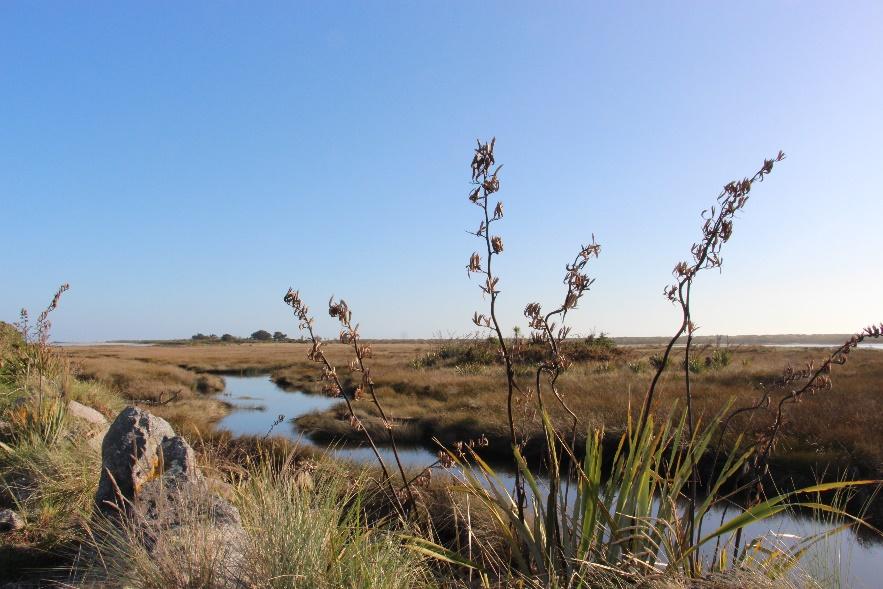
Te Ātiawa o Te-Waka-a-Māui Trust

E titia nei e Te Ātiawa, i te iti, i te rahi, te katoa | To shine as Te Ātiawa, the few, the many, all of us
Tamarau nō runga i te rangi Heke iho ki raro ki te whakamarimari Tē tatari ai, ki te hurahanga o te tāpora o Rongoueroa Taku kuia e, taku kuia e! Te ara o taku tupuna i tohia ai au Ko Te Ātiawa nō runga i te rangi
Key values from Te Ātiawa o Te Waka-a-Māui align with the Alliance values:
Te Ātiawa o Te Waka-a-Māui is proud to be a Kotahitanga mō te Taiao Alliance member. We are invested in transformative change for Te Tau Ihu across te taiao and for all people. This we see aligns well with the overarching vision of the Alliance.
We see our involvement in Project Mahitahi and our participation in the Governance Group as an opportunity to achieve the following activities over the next 12 months: • Work to deliver operational aspects of the programme (weed control, planting preparation, plan development for pest animal control). • Contract in place between Nelson City Council and an iwi provider, to deliver a Cultural Health Monitoring programme, to set a baseline for the Mahitahi catchment. • Complete funding applications for provision of plants to support project. • Community plantings organised and on track for Autumn/Winter 2022. • Communications and Engagement Plan updated, and delivery of key messages through a range of outlets, including at least one article in Nelson City Council publications.
We look forward to being part of the many landscape-scale environmental and restorative developments that the Alliance aspires to achieve in the future.
Pono
Acting with honesty and integrity
Manaaki
Enhancing the mana of others
Kaitiaki
Being good guardians
Pūmau
Inspiring unity and commitment
Titiro whakamuri, Kōkiri whakamua | Look back and reflect so you can move forward.
Te Rūnanga a Rangitāne o Wairau
Ko Tapuae-o-Uenuku te maunga Ko Wairau te awa Ko Kurahaupō te waka
Tini whetū ki te rangi, ko Rangitāne ki te whenua Like the multitudes of stars in the sky, so great is Rangitāne on the earth
Rangitāne have resided in the northern South Island since the migration from the Wairarapa in the sixteenth century under the chiefs Te Huataki, Te Whakamana and Tukanae. We have occupied and used resources within a territory stretching from the Waiau-toa (Clarence) River in the south to the Wairau (Marlborough), including the Nelson Lakes, and north to Kaituna and the Marlborough Sounds and west into the Whakatū (Nelson) area.
There are two key values that have driven the participation of Rangitāne in the Kotahitanga mo te Taiao Alliance:
Kotahitanga

Kia mahi tahi, kia kauanuanu tētahi ki tētahi Working together, respectfully, as one
Kaitiakitanga

Tiakina ā tātau taonga kei ngaro Embracing our responsibility to protect, preserve and enhance our taonga
Our Strategic Plan has a specific and deliberate focus on our Taiao:
Mana Taiao
Toitū te taiao ki tua o ake tonu atu!
Ensuring the integrity and sustainability of our environment! The Alliance brings together a collective rōpu of Crown agencies, iwi partners and the wider Te Tauihu community that enables us to work together to deliver better outcomes for our environment.
A real focus area for us has been highlighting the need for further restoration work of Te Pokohiwi o Kupe and the Wairau Lagoons. We have been heartened by the positive support, commitment and manaaki that our partners across the Alliance have offered, as we work together to not only sustain our environment, but to be good kaitiaki and regenerate it for our future generations.

We have much to look forward to in the years ahead.
He Pokohiwi o Kupe
Credit: Te Rūnanga a Rangitāne o Wairau
Mā whero, mā pango ka oti ai te mahi With red and black the work will be complete
Tasman District Council
There have been many reasons to be pleased with the mahi undertaken within Te Kaunihera o Te Tai o Aorere (Tasman District Council) this year in maintaining the quality of our flora and fauna. We are a region that boasts three National Parks as well a bounty of unique landscapes and native habitats which add to Tasman’s appeal a great place to live and visit. Our environmental-based projects – from reducing the presence of Wilding Conifers in Mount Richmond Forest Park to rejuvenating wetlands and fish passage – have forged on despite challenging times. The work will make a valuable impact on the biodiversity of our special natural areas, as well as providing local employment in the COVID-19 affected job market. However, nothing can be achieved without a plan, workforce, and way of doing things – Tē tōia, tē haumatia. It is for these reasons that Tasman District Council signed onto the Alliance in 2017.
Collaboration with the community and various stakeholders across Te Tauihu is a key part of this process and we are grateful for their ongoing support, funding or sharing of knowledge and resources. We are proud of what has been achieved through the shared vision of the partnership so far and we look forward to seeing more positive outcomes emerging in 2022 and beyond.
Rough Island planting
Credit: Tim Cuff

West Coast Regional Council
Shags
Credit: West Coast Regional Council
The West Coast Regional Council has been a supporting member of the Kotahitanga mō te Taiao (KMTT) Alliance since 2017, recognising that the achievements for the member regions come about from the collaboration of the KMTT Alliance members – tahi ka kaha ake tātou.

We are proud to be involved with the initial strategy development working group, building the picture of what outcomes the KMTT Alliance, and member regions, want to achieve.
Coastal beach of Te Tai Poutini
Credit: West Coast Regional Council The breadth of projects across the KMTT Alliance regions is testament to the aspirations of its representatives, the mahi of the support staff, and the ownership of the projects on the ground.

The future is bright as we continue to work together on behalf of our environment and our communities.
Nelson City Council
Tēnā koutou katoa
Te Kaunihera o Whakatū (Nelson City Council) has been an active member of the Kotahitanga mō te Taiao (KMTT) Alliance since 2017 and strongly endorses the kaupapa of the KMTT Alliance. A sustainable, healthy environment is key to the vision of Whakatū Nelson – He Tāone Tōrire – The Smart Little City – a city that is connected to kaitiakitanga, and caring for, its wildlife and native habitats. As a member of the KMTT Alliance we have been able to collaborate on a much wider scale towards our shared outcomes, and we can see great gains for our biodiversity and our community, and for the future wellbeing of Te Tauihu. In this mahi we are guided by the concept of tūpuna pono (being good ancestors) and we have tomorrow in mind when we make decisions today. Nelson City Council’s 2021-2031 Long Term Plan highlights Council’s commitment to building effective, lasting, and genuine partnerships with all eight iwi of Te Tauihu at both operational and governance levels, and the co-governance of Project Mahitahi with Ngāti Koata Trust, Te Ātiawa Trust, Te Rūnanga o Ngāti Rārua has been a highlight for Council since the project started in October 2020. This year has been challenging, with the shared impacts of climate change and COVID-19 affecting both our community and the natural environment, however the KMTT Alliance has provided a pathway towards addressing some of these impacts. KMTT Alliance projects have provided employment for people, planted carbon-sequestering trees, and supported biodiversity at risk from climate change. As our regional strategic relationships are strengthened though the KMTT Alliance, so too will our resilience to these challenges, and we look forward to working with our KMTT Alliance partners for the wellbeing of our natural environment and our community over the coming year.
Nāku te rourou, nāu te rourou, ka ora ai te iwi.
Each of us has a contribution to make towards a sustainable future for our mokopuna.

Rachel Reese
Mayor of Nelson | Te Koromatua o Whakatū
Cawthron planting day
Credit: Nelson City Council
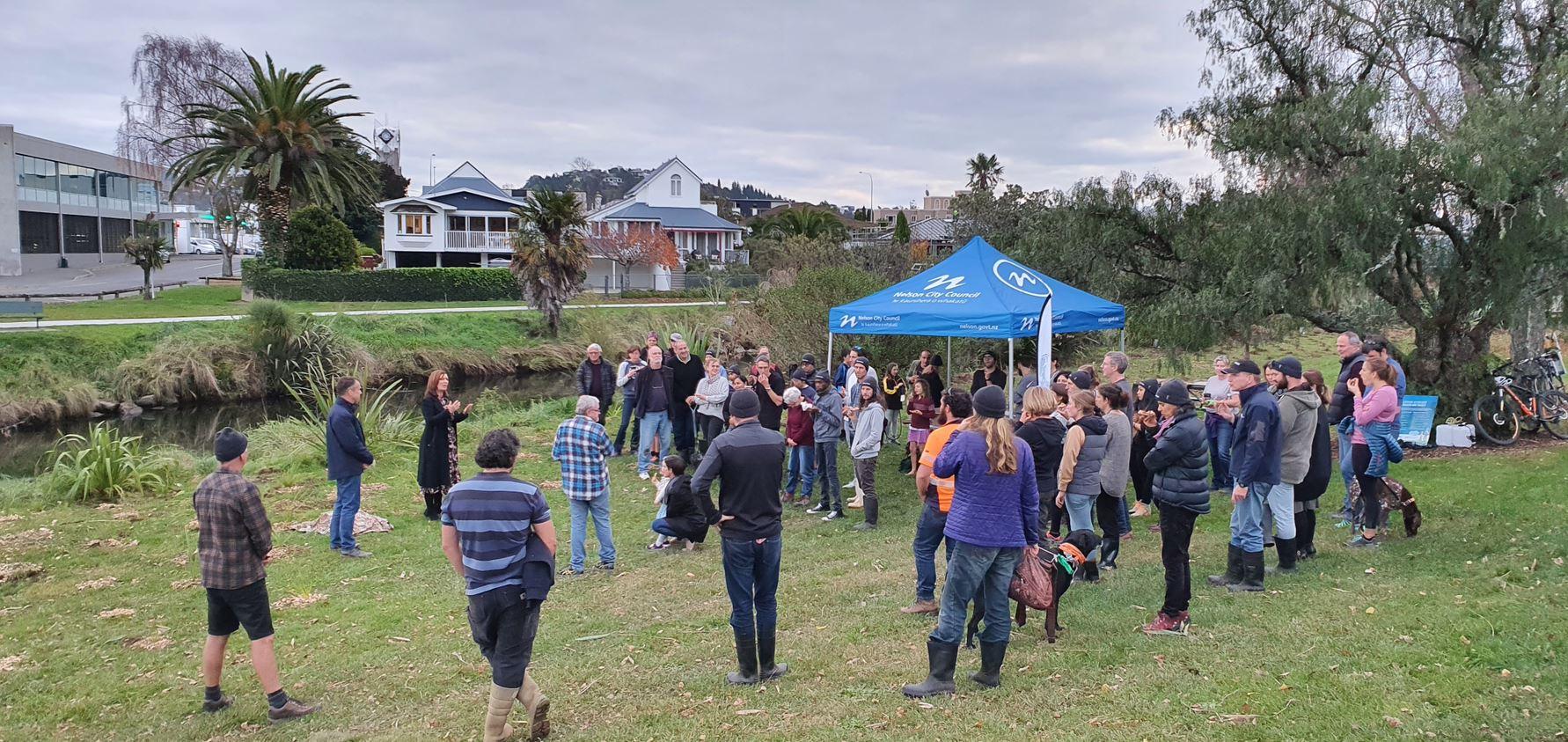
Marlborough District Council
Tēnā koutou katoa
Te Kaunihera ā-Rohe o Wairau (Marlborough District Council) is a committed member of the Kotahitanga mō te Taiao Alliance, sharing in the vision of restoring our natural environments and the communities within them.
As a member of the Alliance, we are stronger than our individual efforts to achieve transformational outcomes for the top of the South Island. The Alliance allows us to build strategic alignment with our partners, especially Te Tauihu iwi, to achieve landscape-scale outcomes. The benefits of the Alliance have only just begun but will be realised for generations to come.
This strength in partnership has been demonstrated by the early successes of the Te Hoiere / Pelorus Project, which was chosen as a pilot example by Kotahitanga mō te Taiao. This backing of the Alliance has given the project a platform for collaboration and accelerated funding. Te Hoiere / Pelorus is the largest river catchment draining into the Marlborough Sounds, and a multi-generational effort to restore its degrading water quality is under way among iwi, Council, Government, and others.

This year, a highlight was the announcement of $7.5 million in additional funding for the Te Hoiere / Pelorus project. This Mahi mō te Taiao / Jobs for Nature funding not only helps to restore Te Hoiere / Pelorus River and its tributaries from the mountains to the sea but also supports training and job creation. Jobs will focus on restoring freshwater across the catchment, eliminating predators and weeds, developing land management tools, and establishing a native nursery. We look forward to the future, as the Kotahitanga mō te Taiao Alliance Strategy will help to guide our district’s strategy for biodiversity to protect this taonga for future generations.
Te Hoiere Awa at Pelorus Bridge
Credit: Oliver Wade
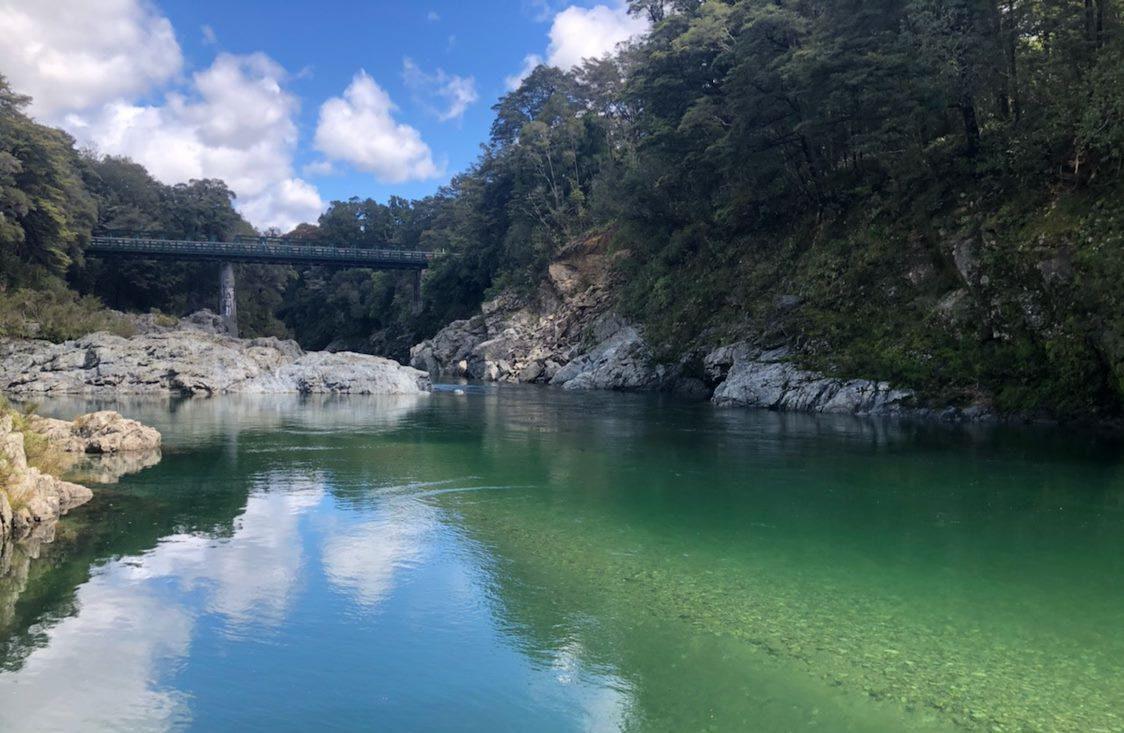
Buller District Council
Buller District Council / Te Kaunihera o Kawatiri has been involved in the Kotahitanga mō te Taiao (KMTT) Alliance since 2017.
The Alliance’s aims and vision complement the Buller District’s aspiration to ensure that our distinctive environment and natural resources are healthy and valued. This vision is a key environmental community outcome identified in the 2021-2031 Long-Term Plan which was developed in consultation with the community. Buller District Council / Te Kaunihera o Kawatiri values the strength and opportunities that the Alliance creates to deliver on this community aspiration. Being surrounded by vast untamed wilderness, two magnificent national parks, and many fragile ecosystems, nature is close to our community’s heart. Participating in, and supporting, the KMTT Alliance is key to fulfilling the community’s vision. Through the partnerships which the Alliance support, Buller District has secured more than $1.4 million of funding to go towards the creation of jobs and weed control in the district.
The funding will create up to eight new Buller-based jobs for three-years to protect, restore, and enhance some of Buller’s most ecologically significant sites, including estuaries, wetlands, lowland forest remnants as well as unique limestone and coal measure ecosystems. These outcomes amplify the strength of the Alliance.
Combining our strengths, the Alliance has enabled the Buller District Council to achieve outcomes for our community and environment that never would have been possible to realise on our own. The Alliance has grown and become a powerful tool to achieve big, bold, and green milestones that move our district towards a thriving green sustainable future for people and nature.
Coastline of Te Tai Poutini
Credit: Buller District Council
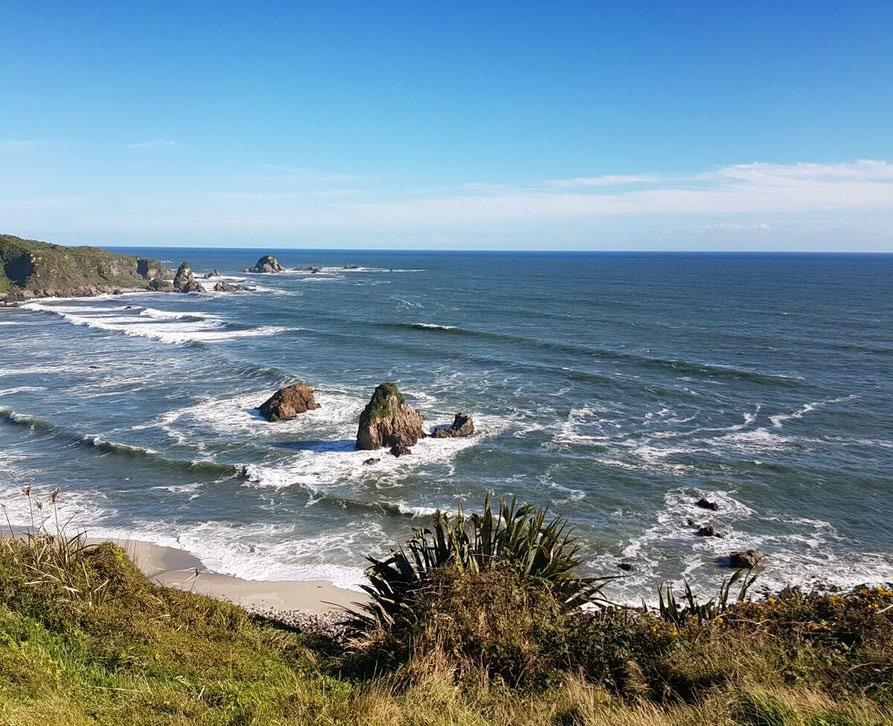
Department of Conservation

Project members, participating in an initial field trip to discuss Te Hoiere/Pelorus Project potential, August 2019
Credit: DOC, Picton Office
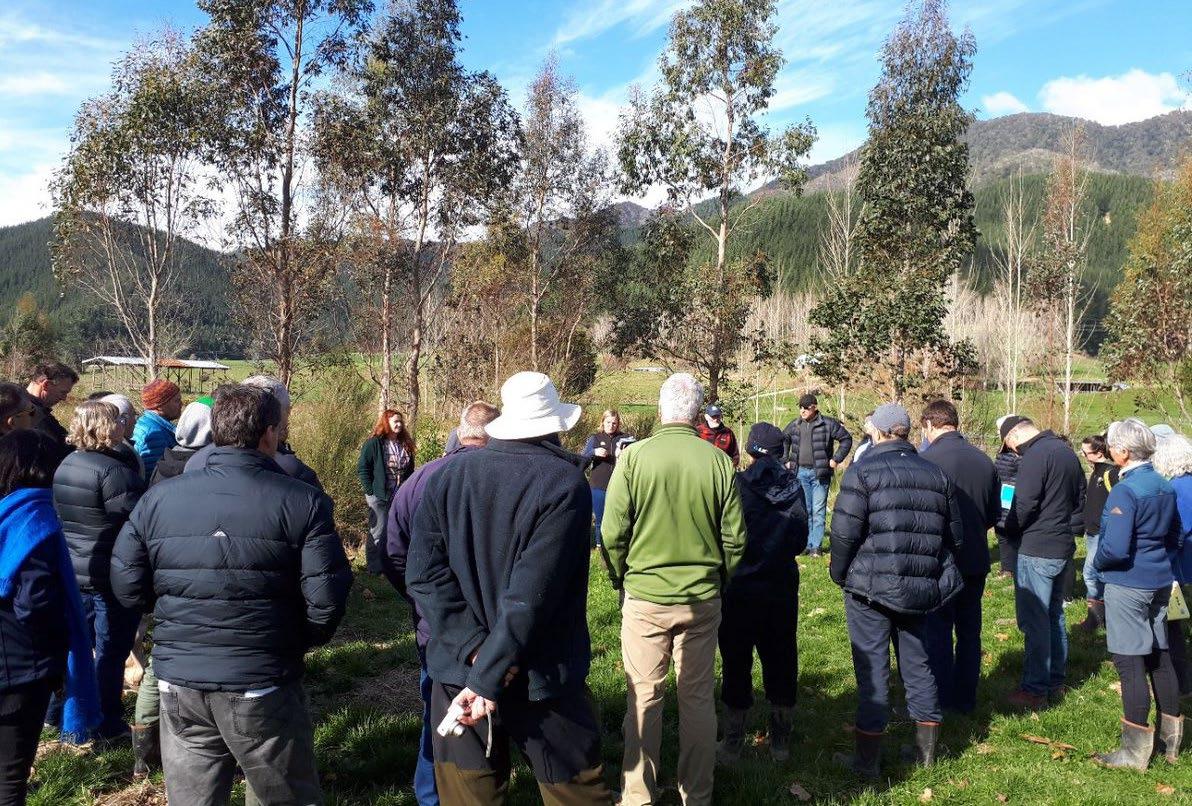
The Department of Conservation (DOC) has been tasked by Cabinet to lead the initial implementation of the Te Mana o Te Taiao – NZ Biodiversity Strategy. The Aotearoa New Zealand Biodiversity Strategy (ANZBS) is a New Zealand strategy. A review and report of lessons learnt from the previous 2000 strategy, and during development of the ANZBS, told us that getting a robust governance system in place, achieving buy-in across the biodiversity sector, setting up effective monitoring and reporting frameworks, and having adequate funding and legislation necessary to achieve the goals of the strategy, are the keys to success. The aim is to ensure the system supports the priorities and different biodiversity needs across our varied agencies, regions, communities, and iwi. For the Department of Conservation (DOC), the Kotahitanga mō te Taiao Alliance has created a new level of possibility for restoring NZ’s biodiversity. The collective knowledge around the table enables hundreds of years of experience and expertise to focus on tackling some of the region’s most complex challenges. Project Janszoon (funded through the NEXT Foundation) demonstrated what can be achieved through collective effort and focused investment. The Project Janszoon Trust directly invested in our Kotahitanga mō te Taiao Strategy, hugely encouraging us to think and act big. The scale and impact of Kotahitanga mō te Taiao is now on an exponential trajectory for achieving environmental outcomes Since its establishment in 2017 the Alliance has achieved some significant gains. Partnering with The Nature Conservancy to provide independent professional programme implementation of the Kotahitanga Strategy. Creation of landscape scorecards for most places within the Strategy. That enables the Alliance to hold a common view of the current state and ‘what good looks like.’
Project Moturoa iwi capacity building training programme is now in its third year of implementation. Over 20 participants having successfully obtained the Level 4 Kaitiaki Whenua certification.
DOC’s Ngā Awa supported project in Te Hoiere / Pelorus now operates under its own governance structure, co-led by the Marlborough District Council and Ngāti Kuia. The partners have completed an indicative business case and a catchment condition survey while also successfully securing multiple funding streams to progress design and implement quick wins. The collaborative Mt Richmond Forest Park wilding conifer control project is operational with Tasman District Council as lead. It seeks to protect the rare and unique ultramafic ecosystem and endemic species contained.
Approximately $22M of Jobs for Nature across 14 projects were stood up to contribute to our strategy and provision nature-based training and employment for many that have been impacted by COVID-19 restrictions.
Mahitahi / Maitai catchment scale restoration was stood-up at pace, replicating Te Hoiere / Pelorus learnings. Joint leads Nelson City Council and Ngāti Koata have secured funding support across multiple agencies and are delivering outcomes across multiple areas, including the neighbouring Brook Waimarama Sanctuary. Kaimahi for Nature Connection Education project with partners Whenua iti Outdoors is enabling 18,000 primary and secondary school children the ability to reconnect to nature and our restoration projects.
Whakapuaka / Whangamoa includes areas of public and privately owned Māori land, now under restoration in partnership with Nelson City Council and Ngāti Tama. A multi region wide weed control programme to protect areas of high biodiversity values, is being led by The Nature Conservancy (TNC) and supported by several subcontractors. Wasp Wipeout – working with Stuff media, TNC and Kotahitanga mō te Taiao are pursuing a 5-year national wasp control programme, trialling landscapescale control for biodiversity outcomes with Manaaki Whenua, Entercol, and NEXT Foundation. Picton Dawn Chorus are targeting rats, mustelids, possums, and feral cats through the expansion of their predator control network in the Picton area. The sum of all these outcomes would not be achievable without the support of our Alliance partners and their connections to others involved in the mahi. Not only are we able to achieve greater things for our environment, but the ability to connect and support the communities at place to do more is instrumental to the successful delivery of our strategies and plans.

The Nature Conservancy
Te Papa Ao Tūroa, Aotearoa, Manaaki Taiao, Tiaki Ora Toitū te marae a Tāne Mahuta Toitū te marae a Tangaroa Toitū te Tangata
The Nature Conservancy (TNC) established its chapter in Aotearoa NZ in 2016 because of the country's global conservation significance and the ability to test new ideas here. Over the past five years, TNC has worked with government officials, local communities, iwi, businesses, and local conservation groups to restore and preserve the country’s precious land, marine and freshwater resources. Partnering with indigenous communities is very important to us and we are committed to supporting Māori to be at the forefront of conservation and restoration efforts.
The size and unique biodiversity of Aotearoa NZ make it an ideal area in which to implement conservation strategies at scale for preservation and restoration work globally. What we do here can create blueprints that can have big impacts elsewhere.
A key part of TNC Aotearoa NZ’s work is supporting landscape-scale projects. This integrated approach to conservation addresses environmental, cultural, social, and economic well-being, is focused on a system level impact, and involves local communities throughout the process.
TNC Aotearoa NZ brings experience, processes, financial tools, science, and global connections in landscape-scale planning and implementation. We are connecting stakeholders in Aotearoa NZ with similar projects in other countries for shared learning experiences and capacity building. We’re partnering with communities to provide them with innovative tools to achieve their conservation aspirations, particularly regarding land-use change and best practices. TNC is very excited to be able to offer our expertise and support to the Kotahitanga mō te Taiao Alliance. We look forward to helping nature and people thrive across Te Tauihu.
Kākā, native bird of Aotearoa Credit: Dave Buckton PhotoNZ





Senior Editor Challen Wilson, The Sisters Consultancy
Te Reo Māori Editor
Matawai Winiata, The Sisters Consultancy
Designer
Raeleen Stonelake, Jitter Ltd

Photography
Melissa Banks Photography, Erik van Eyndhoven, Dave Buckton, Antonia O’Donnell, Rod Alexander, Action Forest Management, Hudson Dodd, Dr Jen Skilton, Andrew Strugnell, Naomi Aporo, Oliver Wade, Tim Cuff, Alliance partner’s photo libraries
Brand Kete
Link to brand kete



